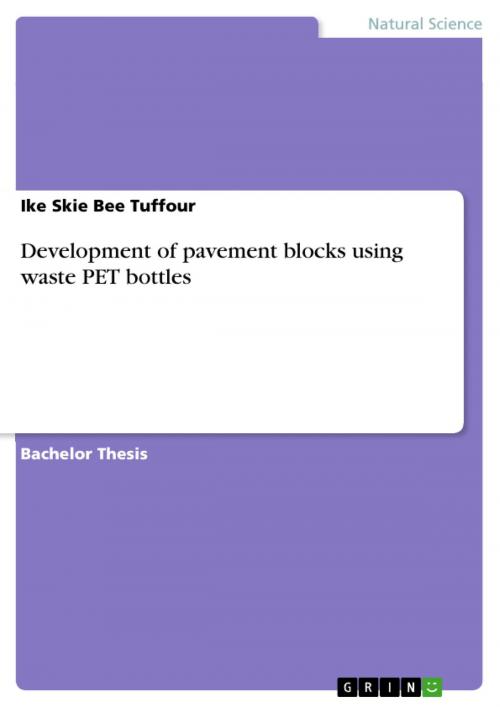Development of pavement blocks using waste PET bottles
Nonfiction, Science & Nature, Technology, Material Science| Author: | Ike Skie Bee Tuffour | ISBN: | 9783668266582 |
| Publisher: | GRIN Verlag | Publication: | July 25, 2016 |
| Imprint: | GRIN Verlag | Language: | English |
| Author: | Ike Skie Bee Tuffour |
| ISBN: | 9783668266582 |
| Publisher: | GRIN Verlag |
| Publication: | July 25, 2016 |
| Imprint: | GRIN Verlag |
| Language: | English |
Bachelor Thesis from the year 2016 in the subject Chemistry - Materials Chemistry, , course: Chemistry, language: English, abstract: The use of waste plastics in concrete pavement block is a partial solution to the environmental and ecological challenges associated with the use of plastics. The aim of this research is to reduce environmental pollution by using waste PET bottles to produce pavement blocks. In this study, Voltic bottles were first used to replace cement in the production of pavement blocks. The polymeric material was first shredded and melted in an aluminum container at a temperature range of 250 ºC - 260 ºC and the quarry dust and sand were added in their respective ratios. In another set of studies, the waste Voltic bottles were used as a partial replacement for quarry dust in the manufacturing of pavement blocks. The cleaned waste plastics bottles were first cut into flakes and then incorporated into the concrete mixture. Test conducted involved the effect of sulphuric acid on the weight of pavement, its water absorption and compressive strength. In the first studies, when PET bottles were used to replace cement, the results obtained had the compressive strength almost the same as that of the control sample which contain no plastic. The percentage water absorbed was less and it also had good resistance for acid. In the second studies when PET was used to replace quarry dust partially, the compressive strength was a little bit lower than the control. Its water absorption was less and it also had good resistance to acid. From the above findings, PET pavement blocks have a good strength and can therefore be used for any construction work.
Bachelor Thesis from the year 2016 in the subject Chemistry - Materials Chemistry, , course: Chemistry, language: English, abstract: The use of waste plastics in concrete pavement block is a partial solution to the environmental and ecological challenges associated with the use of plastics. The aim of this research is to reduce environmental pollution by using waste PET bottles to produce pavement blocks. In this study, Voltic bottles were first used to replace cement in the production of pavement blocks. The polymeric material was first shredded and melted in an aluminum container at a temperature range of 250 ºC - 260 ºC and the quarry dust and sand were added in their respective ratios. In another set of studies, the waste Voltic bottles were used as a partial replacement for quarry dust in the manufacturing of pavement blocks. The cleaned waste plastics bottles were first cut into flakes and then incorporated into the concrete mixture. Test conducted involved the effect of sulphuric acid on the weight of pavement, its water absorption and compressive strength. In the first studies, when PET bottles were used to replace cement, the results obtained had the compressive strength almost the same as that of the control sample which contain no plastic. The percentage water absorbed was less and it also had good resistance for acid. In the second studies when PET was used to replace quarry dust partially, the compressive strength was a little bit lower than the control. Its water absorption was less and it also had good resistance to acid. From the above findings, PET pavement blocks have a good strength and can therefore be used for any construction work.















